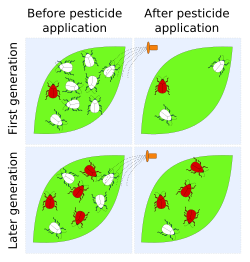
The environmental effects of pesticides describe the broad series of consequences of using pesticides. The unintended consequences of pesticides is one of the main drivers of the negative impact of modern industrial agriculture on the environment. Pesticides, because they are toxic chemicals meant to kill pest species, can affect non-target species, such as plants, animals and humans. Over 98% of sprayed insecticides and 95% of herbicides reach a destination other than their target species, because they are sprayed or spread across entire agricultural fields. [1] Other agrochemicals, such as fertilizers, can also have negative effects on the environment.
Contents
- History
- Modern pesticide usage
- Specific pesticide effects
- Persistent organic pollutants
- Environmental effects
- Air
- Water
- Soil
- Impacts
- Plants
- Animals
- Humans
- Pest resistance
- Pest rebound and secondary pest outbreaks
- Alternatives
- Waste and disposal
- Activated carbon absorption
- Advanced oxidation process (AOP)
- Activism
- Pesticide Action Network
- See also
- Further reading
- References
- External links
The negative effects of pesticides are not just in the area of application. Runoff and pesticide drift can carry pesticides into distant aquatic environments or other fields, grazing areas, human settlements and undeveloped areas. Other problems emerge from poor production, transport, storage and disposal practices. [2] Over time, repeat application of pesticides increases pest resistance, while its effects on other species can facilitate the pest's resurgence. [3] Alternatives to heavy use of pesticides, such as integrated pest management, and sustainable agriculture techniques such as polyculture mitigate these consequences, without the harmful toxic chemical application.
Environmental modelling indicates that globally over 60% of global agricultural land (~24.5 million km²) is "at risk of pesticide pollution by more than one active ingredient", and that over 30% is at "high risk" of which a third are in high-biodiversity regions. [4] [5] Each pesticide or pesticide class comes with a specific set of environmental concerns. Such undesirable effects have led many pesticides to be banned, while regulations have limited and/or reduced the use of others. The global spread of pesticide use, including the use of older/obsolete pesticides that have been banned in some jurisdictions, has increased overall. [6] [7]












